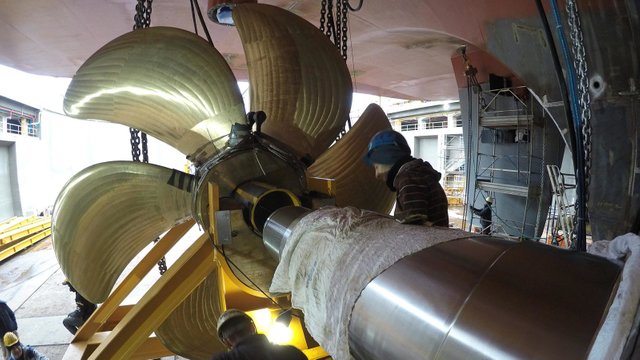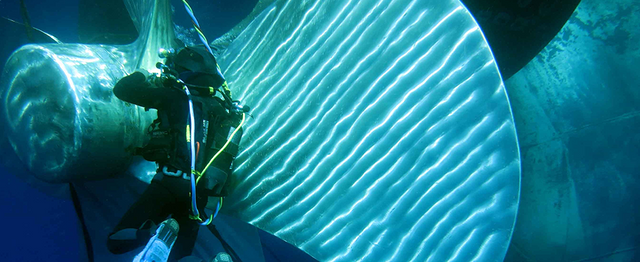How A Giant Ship Is Actually Made?
The World of Ship Propellers and Engines
Building a massive ship requires a massive amount of engineering work even the smallest parts of a ship require lots of time and effort to design and build if you've ever seen a giant ship and its construction you've probably noticed the large propellers these propellers are crucial to making the ship sail along with the ship engines without these two components the ship wouldn't be able to operate as it should the propeller is used to propel the ship by using the power generated and transmitted by the ship's main engine these two elements of the ship always work together even though they're quite different a ship propeller is used for propulsion in most types of vessels although most gigantic vessels manage to take our breath away with their sheer size it's the engineering Marvel behind them that makes them truly remarkable.
Ship propellers and engines are the main elements that keep the ship moving and on each ship these two are made to withstand the weight of the giant ship today we have a few different types of propellers such as (Fixed-Pitch propellers and Controllable-Pitch propellers).
The fixed pitch propellers have blades that are permanently attached to the hub and the pitch's position cannot change during operation they are robust and reliable as the system doesn't incorporate any mechanical or hydraulic connections however the maneuverability of these propellers is not as good as the controllable pitch propellers because of that they're used on ships that don't require good maneuverability the controllable pitch propellers allowed the pitch to be altered by rotating the blade about its vertical axis since they're controllable the maneuverability improves and the engine efficiency increases.
How are Ship Propellers Manufactured?
No matter the type of propeller their manufacturing process is just as mesmerizing as each propeller produced looking at how they're made from scratch to the final finished product makes you appreciate how far we've come from the days when propellers were first introduced when designing a propeller dozens of variables have to be considered to design the most efficient propeller possible.
A poorly designed propeller can lead to poor fuel efficiency or low top speeds and even reduce the lifespan of other ship components choosing the right material is also the key to making a lasting propeller most ship propellers are made from corrosion resistant materials as they're used directly in seawater which is a corrosion accelerator the materials used for propellers are an alloy of Aluminum and Stainless Steel.
Other popular materials used are nickel aluminum and bronze Alloys which are lighter than other materials and have higher strength after the design is selected and the material is carefully chosen the molten metal is poured into a mold and is left to cool because the propeller is so massive sometimes the metal can take five days to cool and Harden after the metal is cooled the mold is broken off and the propeller is sent to the milling machine this machine is computer controlled and the Machine spends the next 15 days polishing the propeller the entire process of manufacturing your propeller can take 3 to 5 weeks after production the propeller can finally be attached to the ship given that the propeller is used to drive the ship and is constantly underwater certain measures must be considered when making the propeller.
How are Ship Engines Manufactured?
The engine and the propeller work together to allow the ship to sail at the right speed efficiently most of the engines used on giant ships today are diesel engines there are two types of ship engines a four-stroke and a two-stroke engine.
The four-stroke engines are used on smaller vessels and produce electrical power and Propel the ship while the two-stroke engines are used on massive vessels for propulsion and are much bigger compared to the four-stroke engines if you've ever seen a ship engine then you must have wondered how are they made?
Most modern ships currently use diesel engines as their prime mover they're simple to operate and they're fuel efficient compared to other ship engines ship engines are one of the world's biggest and most expensive engines it requires fires great engineering skills and resources to manufacture such massive Machinery which is responsible for the propulsion of the ship the criteria for purchasing a ship engine are higher speed economical fuel consumption and long Machinery Life currently there are multiple engine manufacturers worldwide all working on creating the best ship engine each competes to create the best engine that will have a long life and serve the ship without any setbacks.
Most diesel engines will run an average of five thousand dollars before needing a major overhaul and they use around 2 623 gallons of diesel fuel per hour all this makes the engine one extremely complicated machine in order to get it just right manufacturers spend years perfecting it one engine can spend a year in production before it's mounted on a ship once the engine is completed and mounted on the ship it needs to undergo test trials to ensure that the engine doesn't have any faults.
Evolution of Ship Propellers and Engines
Today we see a lot of high technology propellers and engines however their history is quite extraordinary the origin of the screw propeller starts as early as Archimedes who used his screw to lift water for irrigation in boiling boats known as the Archimedes crew this precursor of the modern day propeller was used quite a bit in the past one of the first practical and applied uses of her propeller was on a submarine named Turtle which was designed in 1775.
The first official propeller used for propulsion was made in 1827. this propeller was installed on a steamboat and reached speeds of around 6 knots over the years propellers continued to evolve with modern technology able to hone and fine-tune efficiency up to approximately 70 percent and come in various designs the first Advanced Mechanical means of marine propulsion was the marine steam engine this engine was introduced in the 19th century during the 20th century the engine was replaced by two-stroke or four-stroke diesel engines outboard motors and gas turbine engines on faster ships however before the introduction of steam engines on ships oars and wind were the main sources of watercraft propulsion over the years many Engineers tried to make different types of ship engines to evolve from steam-powered engines.
In 1903 the first diesel ship engine came into use which soon proved to have greater efficiency than the steam turbine but for many years had an inferior power to space ratio however over the years it's been proved that diesel engines are the most efficient to use on ships these engines have evolved from the first time they were introduced today's ships that used diesel engines do not generally need gearboxes ships propelled by medium or high-speed diesel engines usually have one or two propellers commonly with one or more engines driving each propeller shaft through a gearbox.
We've come a long way since the first inventions of propellers and engines today huge ships need only one engine and one or two propellers to propel the ship
Ship Propeller Maintenance
Engineers and Manufacturers of ship propellers havefigured out a way to minimize corrosion on their propellers however each propeller needs to have the proper maintenance over the course of its life to work efficiently
Since they are responsible for moving the ship these propellers can endure a lot of stress and damage over their working courses they're quite complicated and even though they can last a long time regular checks are a must they're constantly exposed to seawater which can sometimes create corrosion on their propeller even though it's made from anti-corrosive materials.
The corrosion effect in bronze propellers has a minor effect on seawater however this corrosion needs to be removed frequently maintenance of the ship propeller requires frequent checks in the propeller in this process the propeller must be cleaned thoroughly removing all Marine growth and barnacles the propeller then needs to be checked for any cracks dents or scratches
If these small damages are ignored the propeller can deteriorate to a point that it'll have to be replaced there are many types of damage that can occur on a propeller whether done accidentally or acquired by strikes.
The damage can result in chipping loss of metal or even blade deformation the most severe damage is the loss of a complete blade making a propeller irreparable on giant ships carrying enormous weight these maintenance checks are often done by a crew that goes underwater and inspects the propeller there they also clean the propeller from Barnacles and inspect it in detail.
If any damage is found then they quickly act on it and fix what's damaged today there are numerous ways to maintain and repair a propeller and with the right Care One propeller can last a very long time.

